Joan Crawford
Joan Crawford (born Lucille Fay LeSueur; March 23, 190?[Note 1] – May 10, 1977) was an American film and television actress who began her career as a dancer in traveling theatrical companies before debuting as a chorus girl on Broadway. Crawford then signed a motion picture contract with Metro-Goldwyn-Mayer in 1925; her career spanned six decades, multiple studios, and controversies.
Joan Crawford | |
|---|---|
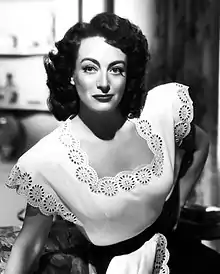 Crawford in Humoresque, 1946 | |
| Born | Lucille Fay LeSueur March 23, 190? (uncertain)[Note 1] San Antonio, Texas, U.S. |
| Died | May 10, 1977 Manhattan, New York City, New York, U.S. |
| Resting place | Ferncliff Cemetery, Hartsdale, New York, U.S. |
| Occupation |
|
| Years active | 1925–1972 |
| Spouse(s) | |
| Children | 4 (adopted), including Christina Crawford |
| Relatives | Hal LeSueur (brother) |
| Signature | |
 | |
At different stages of her career, she was noted for her diverse roles playing sympathetic and unsympathetic characters, and for realistic yet multi-layered performances. Her greatest success and most popular performances came from melodramas and romantic comedies, but her filmography ranges in genres from film noir and historical costume dramas to musicals and horror films. In 1999, the American Film Institute ranked Crawford tenth on its list of the greatest female stars of Classic Hollywood Cinema.
In the 1930s, Crawford's fame rivaled and later surpassed that of MGM colleagues Norma Shearer and Greta Garbo. Though she started by portraying flappers, Crawford often played wealthy women in distress (Dance, Fools, Dance, This Modern Age, Letty Lynton, No More Ladies, I Live My Life, Susan and God) or hard-working young women who found romance and success (Our Dancing Daughters, Paid, Laughing Sinners, Grand Hotel, Dancing Lady, Sadie McKee, The Last of Mrs. Cheyney, The Shining Hour, The Bride Wore Red, Mannequin). These characters and stories were well received by Depression-era audiences, and were popular with women. Crawford became one of Hollywood's more prominent movie stars, and one of the higher-paid women in the United States.
In 1938, she was among a group of actresses deemed "box office poison" by theater owners, until her pivotal role in the all-female cast of 1939's The Women gained her praise from critics and audiences alike. Her success continued with a performance as a facially disfigured criminal in the melodrama A Woman's Face, which garnered her critical acclaim. In 1945, she won the Academy Award for Best Actress for her portrayal of the hard-working, divorced, protective mother in the title role of Mildred Pierce. Crawford also received two Best Actress Award nominations as recognition for her work in Possessed (1947) and Sudden Fear (1952).
In 1954, she starred in the Western Johnny Guitar, although unsuccessful during its original release, the cult film has since been lauded. In 1955, Crawford became involved with the Pepsi-Cola Company through her marriage to company Chairman and Chief Executive Officer Alfred Steele, although she continued to act in film and television throughout the 1950s and 1960s. In 1962, she starred alongside long-time rival Bette Davis in the horror film Whatever Happened to Baby Jane?, which once again returned her to critical acclaim and box office success, with many believing she would receive another Oscar nomination, however she did not.[12]
In 1970 Crawford made her last theatrical film, and until a few weeks before her death, she continued to tape numerous regular radio spots and announcements for a variety of not-for-profit causes. Following a public appearance in 1974, she withdrew from events that required her to be photographed, becoming increasingly reclusive until her death in 1977.[13]
Crawford married four times. Her first three marriages ended in divorce; the last ended with the death of husband Alfred Steele. She adopted five children, one of whom was reclaimed. Crawford's relationships with her two eldest children, Christina and Christopher, were acrimonious. After Crawford's death, Christina released a well-known but controversial "tell-all" memoir, Mommie Dearest (1978).[14]
Early life
Born Lucille Fay LeSueur, of French-Huguenot, English, Dutch, and Irish ancestry[15][16] in San Antonio, Texas, she was the third and youngest child of Tennessee-born Thomas E. LeSueur (January 2, 1867[17][18]– January 1, 1938), a construction laborer, and Texas-born Anna Bell Johnson (later Mrs. Anna Cassin), whose date of birth is given as November 29, 1884, although, based on census records, she may have been older. She apparently was still under 20 when her first two children were born. She died on August 15, 1958.[15] Crawford's elder siblings were sister Daisy LeSueur, who died before Lucille's birth, and brother Hal LeSueur.[19]
Thomas LeSueur abandoned the family when Lucille was ten months old,[20] eventually resettling in Abilene, Texas, reportedly working as a construction laborer.[19] Crawford's mother married Henry J. Cassin, however, the marriage is listed in the census as her first.[21] They lived in Lawton, Oklahoma where Cassin ran the Ramsey Opera House; he managed to book diverse and noted performers such as Anna Pavlova and Eva Tanguay. As a child, Crawford preferred the nickname "Billie" and enjoyed watching vaudeville acts perform on the stage of her stepfather's theatre. At that time, Crawford was reportedly unaware that Cassin, whom she referred to as "daddy", was not her biological father until her brother Hal told her the truth.[22] Cassin allegedly began sexually abusing her when she was eleven years old, and continued until she was sent to St. Agnes Academy, a Catholic girls' school.[23][24]
Beginning in childhood, Crawford's ambition was to be a dancer. One day in an attempt to escape piano lessons, she leapt from the front porch of her home and cut her foot severely on a broken milk bottle.[25] As a result, she underwent three surgeries to repair the damage. She was unable to attend elementary school or continue with dancing lessons for 18 months.[25]
In June 1917, the family moved to Kansas City, Missouri, after Cassin was accused of embezzlement; although acquitted, he was blacklisted in Lawton.[21] Following their relocation, Cassin, a Catholic, placed Crawford at St. Agnes Academy in Kansas City. When her mother and stepfather separated, she remained at school as a work student, where she spent far more time working, primarily cooking and cleaning, than studying. She later attended Rockingham Academy, also as a working student.[26] While there, she began dating, and had her first serious relationship with a trumpet player named Ray Sterling, who reportedly inspired her to begin challenging herself academically.[27]
In 1922, she registered at Stephens College in Columbia, Missouri, giving her year of birth as 1906.[28] She attended Stephens for only a few months before withdrawing after she realized she was not prepared for college.[29] Her family's instability negatively affected Crawford and her schooling never formally progressed beyond primary education.[30]
Career
Early career
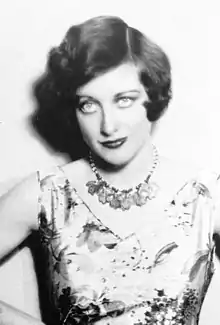
Under the name Lucille LeSueur, Crawford began dancing in the choruses of traveling revues, and was spotted dancing in Detroit by producer Jacob J. Shubert.[30] Shubert put her in the chorus line for his 1924 show, Innocent Eyes, at the Winter Garden Theatre on Broadway in New York City. While appearing in Innocent Eyes, Crawford met a saxophone player named James Welton. The two were allegedly married in 1924, and lived together for several months, although this supposed marriage was never mentioned in later life by Crawford.[31]
Crawford wanted additional work, and approached Loews Theaters publicist Nils Granlund. Granlund secured a position for her with singer Harry Richman's act and arranged for her to do a screen test which he sent to producer Harry Rapf in Hollywood.[32] Rapf notified Granlund on December 24, 1924, that Metro-Goldwyn-Mayer (MGM) had offered Crawford a contract at $75 a week. Granlund immediately wired LeSueur, who had returned to her mother's home in Kansas City, with the news; she borrowed $400 for travel expenses.[33]
Credited as Lucille LeSueur, her first film was Lady of the Night in 1925, as the body double for Norma Shearer, MGM's most popular female star. She also appeared in The Circle and Pretty Ladies (both 1925), starring comedian ZaSu Pitts. This was soon followed by equally small and unbilled roles in two other 1925 silent films: The Only Thing, and The Merry Widow.[34]
MGM publicity head Pete Smith recognized her ability to become a major star, but felt her name sounded fake; he told studio head Louis B. Mayer that her last name, LeSueur, reminded him of a sewer. Smith organized a contest called "Name the Star" in Movie Weekly to allow readers to select her new stage name. The initial choice was "Joan Arden", but after another actress was found to have prior claim to that name, the alternate surname "Crawford" became the choice. She later said that she wanted her first name to be pronounced Jo-Anne, and that she hated the name Crawford because it sounded like "crawfish", but also admitted she "liked the security" that went with the name.[35]
Self-promotion, and early successes
Growing increasingly frustrated over the size and quality of the parts she was given, Crawford embarked on a campaign of self-promotion. As MGM screenwriter Frederica Sagor Maas recalled, "No one decided to make Joan Crawford a star. Joan Crawford became a star because Joan Crawford decided to become a star."[36] She began attending dances in the afternoons and evenings at hotels around Hollywood and at dance venues on the beach piers, where she often won dance competitions with her performances of the Charleston and the Black Bottom.[37]
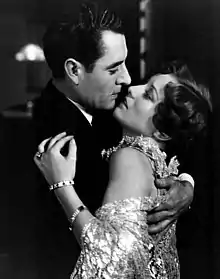
Her strategy worked and MGM cast her in the film where she first made an impression on audiences, Edmund Goulding's Sally, Irene and Mary (1925). From the beginning of her career, Crawford considered Norma Shearer – the studio's most-popular actress – her professional nemesis. Shearer was married to MGM Head of Production Irving Thalberg; hence, she had the first choice of scripts, and had more control than other stars in what films she would and would not make. Crawford was quoted to have said: "How can I compete with Norma? She sleeps with the boss!"[38]
Crawford was named one of 1926's WAMPAS Baby Stars, along with Mary Astor, Dolores del Río, Janet Gaynor, and Fay Wray, among others. That same year, she co-starred in Paris with Charles Ray. Within a few years, she became the romantic lead to many of MGM's top male stars, including Ramón Novarro, John Gilbert, William Haines, and Tim McCoy.[39][40]
Crawford appeared as a skimpily-clad young carnival assistant in The Unknown (1927), starring Lon Chaney, Sr. as a carnival knife thrower with no arms who hopes to marry her. She stated that she learned more about acting from watching Chaney work than from anyone else in her career. "It was then", she said, "I became aware for the first time of the difference between standing in front of a camera, and acting." Also in 1927, she appeared alongside her close friend, William Haines, in Spring Fever, which was the first of three movies the duo made together.[41][42]
In 1928, Crawford starred opposite Ramón Novarro in Across to Singapore, but it was her role as Diana Medford in Our Dancing Daughters (1928) that catapulted her to stardom. The role established her as a symbol of modern 1920s-style femininity which rivaled Clara Bow, the original "It girl", and Hollywood's foremost flapper. A stream of hits followed Our Dancing Daughters, including two more flapper-themed movies, in which Crawford embodied for her legion of fans (many of whom were women) an idealized vision of the free-spirited, all-American girl.[43]
F. Scott Fitzgerald wrote of Crawford:[44]
Joan Crawford is doubtless the best example of the flapper, the girl you see in smart night clubs, gowned to the apex of sophistication, toying iced glasses with a remote, faintly bitter expression, dancing deliciously, laughing a great deal, with wide, hurt eyes. Young things with a talent for living.
Crawford described her glamorous onscreen persona more succinctly, saying, "If you want to see the girl next door, go next door."[45]
On June 3, 1929, Crawford married Douglas Fairbanks, Jr. at Saint Malachy's Roman Catholic Church (known as "The Actors' Chapel", owing to its proximity to Broadway theatres) in Manhattan, although neither was Catholic.[46] Fairbanks was the son of Douglas Fairbanks and the stepson of Mary Pickford, who were considered Hollywood royalty. Fairbanks, Sr., and Pickford were opposed to the marriage, and did not invite the couple to their home at Pickfair for eight months after the marriage.[15]
The relationship between Crawford and Fairbanks, Sr., eventually warmed; she called him Uncle Doug, and he called her Billie, her childhood nickname, but one that close friends used throughout her life.[47] She and Pickford, however, continued to despise each other. Following that first invitation, Crawford and Fairbanks, Jr., became more frequent guests. While the Fairbanks men played golf together, Crawford was either left with Pickford, who would retire to her quarters, or simply left alone.[48]
To rid herself of her Southwestern accent, Crawford tirelessly practiced diction and elocution. She said:[49]
If I were to speak lines, it would be a good idea, I thought, to read aloud to myself, listen carefully to my voice quality and enunciation, and try to learn in that manner. I would lock myself in my room and read newspapers, magazines and books aloud. At my elbow, I kept a dictionary. When I came to a word I did not know how to pronounce, I looked it up and repeated it correctly fifteen times.
Transition to sound, and continued success
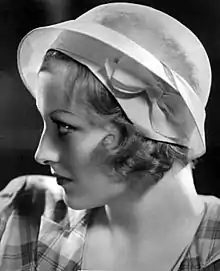
After the release of The Jazz Singer in 1927—the first feature-length film with some audible dialogue—sound films became all the rage. The transition from silent to sound caused panic for many, if not all, involved with the film industry; many silent film stars found themselves unemployable because of their undesirable voices and hard-to-understand accents, or simply because of their refusal to make the transition to talkies.
Many studios and stars avoided making the transition as long as possible, especially MGM, which was the last of the major studios to switch over to sound. The Hollywood Revue of 1929 was one of the studio's first all-talking films, and their first attempt to showcase their stars' ability to make the transition from silent to sound. Crawford was among the dozen or more MGM stars included in the movie; she sang the song "Got a Feeling for You" during the film's first act.
Crawford made a successful transition to talkies with her first starring role in the all-talking feature-length film in Untamed (1929), co-starring Robert Montgomery. Despite the success of the film at the box office, it received mixed reviews from critics, who noted that while Crawford seemed nervous at making the transition to sound, she had become one of the most popular actresses in the world.[50] Montana Moon (1930), an uneasy mix of Western clichés and music, teamed her with John Mack Brown and Ricardo Cortez. Although the film had problems with censors, it was a major success at the time of its release. Our Blushing Brides (1930) the final installment in the Our Dancing Daughters franchise co-starring Robert Montgomery and Anita Page, where Crawford "carries the burden of dramatics in this photoplay and comes off splendidly and intelligently."[51] Her next movie, Paid (1930), paired her with Robert Armstrong, and was another success. During the early sound era, MGM began to place Crawford in more sophisticated roles, rather than continuing to promote her flapper-inspired persona of the silent era.[52]
In 1931, MGM cast Crawford in five films. Three of them teamed her opposite Clark Gable, the studio's soon to be biggest male star and "King of Hollywood".[53] Dance, Fools, Dance, released in February 1931, was the first pairing of Crawford and Gable. Their second movie together, Laughing Sinners, released in May 1931, was directed by Harry Beaumont, and also co-starred Neil Hamilton. Possessed, their third film together, released in October, was directed by Clarence Brown.[54] These films were immensely popular with audiences and were generally well received by critics, stapling Crawford's position as one of MGM's top female stars of the decade along with Norma Shearer, Greta Garbo and Jean Harlow. Her only other notable film of 1931, This Modern Age, was released in August and despite unfavorable reviews was a moderate success.[55]
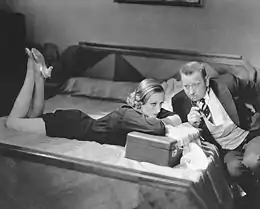
MGM next cast her in the film Grand Hotel, directed by Edmund Goulding. As the studio's first all-star production, Crawford co-starred opposite Greta Garbo, John and Lionel Barrymore, and Wallace Beery, among others. Receiving third billing, she played the middle-class stenographer to Beery's controlling general director. Crawford later admitted to being nervous during the filming of the movie because she was working with accomplished actors, and that she was disappointed that she had no scenes with one she had admired, the "divine Garbo".[56] Grand Hotel was released in April 1932 to critical and commercial success.[57] It was one of the highest-grossing movies of the year,[58] and won the Academy Award for Best Picture.[59]
Crawford achieved continued success in Letty Lynton (1932). Soon after this movie's release, a plagiarism suit forced MGM to withdraw it; it is therefore considered the "lost" Crawford film. Designed by Adrian, the gown with large ruffled sleeves which Crawford wore in the movie became a popular style that same year, and was even copied by Macy's.[60]
On loan to United Artists, she played prostitute Sadie Thompson in Rain (1932), a film version of John Colton's 1923 play. Actress Jeanne Eagels played the role on stage, and Gloria Swanson had originated the part on screen in the 1928 film version. Crawford's performance was panned, and the film was not a success.[61] Despite the failure of Rain, in 1932, the publishing of the first "Top Ten Money-Making Stars Poll" placed Crawford third in popularity at the box office, behind only Marie Dressler and Janet Gaynor. She remained on the list for the next several years, last appearing on it in 1936. In May 1933, Crawford divorced Fairbanks citing "grievous mental cruelty". Crawford claimed Fairbanks had "a jealous and suspicious attitude" toward her friends, and that they had "loud arguments about the most trivial subjects" lasting "far into the night".[62]

Following her divorce, she was again teamed with Clark Gable, along with Franchot Tone and Fred Astaire, in the hit Dancing Lady (1933), in which she received top billing. She next played the title role in Sadie McKee (1934), opposite Tone and Gene Raymond. She was paired with Gable for the fifth time in Chained (1934), and for the sixth time in Forsaking All Others (1934). Crawford's films of this era were some of the most-popular and highest-grossing films of the mid-1930s.[63]
In 1935, Crawford married Franchot Tone, a stage actor from New York who planned to use his film earnings to finance his theatre group. The couple built a small theatre at Crawford's Brentwood home, and put on productions of classic plays for select groups of friends that lived in the popular Brentwood area like Clark Gable and Charley Chase.[64] Tone and Crawford had first appeared together in Today We Live (1933), but Crawford was hesitant about entering into another romance so soon after her split from Fairbanks.[65]
Before and during their marriage, Crawford worked to promote Tone's Hollywood career, but he was not interested in being a star, ultimately wanting to just be an actor, and Crawford wearied of the effort.[66] During their marriage they tried on two separate occasions for children, both ending in miscarriage.[13] Tone allegedly began drinking and became physically abusive. She filed for divorce, which was granted in 1939.[67] Crawford and Tone later rekindled their friendship, and Tone even proposed in 1964 that they remarry. When he died in 1968, Crawford arranged for him to be cremated and his ashes scattered at Muskoka Lakes, Canada.[68]
Crawford continued her reign as a popular movie actress well into the mid-1930s. No More Ladies (1935) co-starred Robert Montgomery and then-husband Franchot Tone, and was a success. Crawford had long pleaded with MGM's head Louis B. Mayer to cast her in more dramatic roles, and although he was reluctant, he cast her in the sophisticated comedy-drama I Live My Life (1935), directed by W. S. Van Dyke, and it was well received by critics.
She next starred in The Gorgeous Hussy (1936), opposite Robert Taylor and Lionel Barrymore, as well as Tone. It was a critical and box-office success, and became one of Crawford's biggest hits of the decade. Love on the Run (1936), a romantic comedy directed by W. S. Van Dyke, was her seventh film co-starring Clark Gable.
"Box office poison"
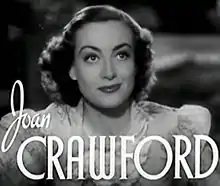
Even though Crawford remained a respected MGM actress, and her films still earned profits, her popularity declined in the late 1930s. In 1937, Crawford was proclaimed the first "Queen of the Movies" by Life magazine. She unexpectedly slipped from seventh to sixteenth place at the box office that year, and her public popularity also began to wane.[69] Richard Boleslawski's comedy-drama The Last of Mrs. Cheyney (1937) teamed her opposite William Powell in their sole screen pairing. The film was also Crawford's last box-office success before the onset of her "box office poison" period.
She co-starred opposite Franchot Tone for the seventh—and final—time in The Bride Wore Red (1937). The film was generally unfavorably reviewed by the majority of critics. It also ran a financial loss, becoming one of MGM's biggest failures of the year. Mannequin, co-starring Spencer Tracy, also released in 1937 did, as the New York Times stated, "restore Crawford to her throne as queen of the working girls".
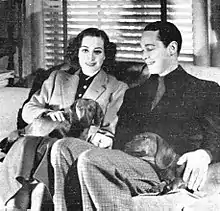
On May 3, 1938, Crawford—along with Greta Garbo, Norma Shearer, Luise Rainer, John Barrymore, Katharine Hepburn, Fred Astaire, Dolores del Río, and others—was dubbed "Box Office Poison" in an open letter in the Independent Film Journal. The list was submitted by Harry Brandt, president of the Independent Theatre Owners Association of America. Brandt stated that while these stars had "unquestioned" dramatic abilities, their high salaries did not reflect in their ticket sales, thus hurting the movie exhibitors involved. Crawford's follow-up movie, The Shining Hour (1938), co-starring Margaret Sullavan and Melvyn Douglas, was well received by critics, but it was a box-office flop.[70]
She made a comeback in 1939 with her role as home-wrecker Crystal Allen in The Women, opposite her professional nemesis, Norma Shearer. A year later, she played against type in the unglamorous role of Julie in Strange Cargo (1940), her eighth—and final—film with Clark Gable. She later starred as a facially disfigured blackmailer in A Woman's Face (1941), a remake of the Swedish film En kvinnas ansikte which had starred Ingrid Bergman in the lead role three years earlier. While the film was only a moderate box office success, Crawford's performance was hailed by many critics.[71]
Crawford adopted her first child, a daughter, in 1940. Because she was single, California law prevented her from adopting within the state; so, she arranged the adoption through an agency in Las Vegas. The child was temporarily called Joan, until Crawford changed her name to Christina. Crawford married actor Phillip Terry on July 21, 1942, after a six-month courtship.[72] Together, the couple adopted a son whom they named Christopher, but his birth mother reclaimed the child. The couple adopted another boy, whom they named Phillip Terry, Jr. After the marriage ended in 1946, Crawford changed that child's name to Christopher Crawford.
After 18 years, Crawford's contract with MGM was terminated by mutual consent on June 29, 1943. In lieu of the last film remaining under her contract, MGM bought her out for $100,000.
Move to Warner Bros.
For $500,000, Crawford signed with Warner Bros. for a three-movie deal, and was placed on the payroll on July 1, 1943. Her first film for the studio was Hollywood Canteen (1944), an all-star morale-booster film that teamed her with several other top movie stars at the time. Crawford said one of the main reasons she signed with Warner Bros. was because she wanted to play the character "Mattie" in a proposed 1944 film version of Edith Wharton's novel Ethan Frome (1911).
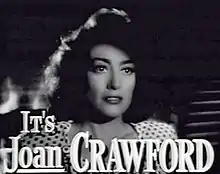
She wanted to play the title role in Mildred Pierce (1945), but Bette Davis was the studio's first choice. However, Davis turned the role down. Director Michael Curtiz did not want Crawford to play the part, and he instead lobbied for the casting of Barbara Stanwyck. Warner Bros. defied Curtiz and cast Crawford in the film. Throughout the entire production of the movie, Curtiz criticized Crawford. "She comes over here with her high-hat airs and her goddamn shoulder pads... Why should I waste my time directing a has-been?"[73] Curtiz demanded Crawford prove her suitability by taking a screen test; she agreed. After the test, Curtiz agreed to Crawford's casting. Costume fittings started filming off roughly when Curtiz suspected Crawford of wearing shoulder pads and he proceeded to tear the top of her dress. She said "Thankfully I was wearing a bra."[74] Mildred Pierce was a resounding critical and commercial success. It epitomized the lush visual style and the hard-boiled film noir sensibility that defined Warner Bros. movies of the late forties. Crawford earned the Academy Award for Best Actress in a Leading Role.[75]
The success of Mildred Pierce revived Crawford's movie career. For several years, she starred in what were called "a series of first-rate melodramas". Her next film was Humoresque (1946), co-starring John Garfield, a romantic drama about a love affair between an older woman and a younger man. She starred alongside Van Heflin in Possessed (1947), for which she received a second Academy Award nomination. In Daisy Kenyon (1947), she appeared opposite Dana Andrews and Henry Fonda, and in Flamingo Road (1949), her character has an ultimately deadly feud with a corrupt southern sheriff played by Sydney Greenstreet. She made a cameo in It's a Great Feeling (1949), poking fun at her own screen image. In 1950, she starred in the film noir The Damned Don't Cry and in the melodrama Harriet Craig.
In 1947, Crawford adopted two more children, whom she named Cindy and Cathy. The children were adopted from Tennessee Children's Home Society, an orphanage/child-trafficking unit operated by Georgia Tann, a source used by many childless Hollywood stars to adopt[76] until Tann's discovery and death erupted in infamy in 1952.[77]
After the completion of This Woman Is Dangerous (1952), a film Crawford called her "worst", she asked to be released from her Warner Bros. contract. By this time, she felt Warners was losing interest in her due to "feeble scripts, poor leading men and inept cameramen", so she decided it was time to move on.[78] Later the same year, she received her third—and final—Academy Award nomination for Sudden Fear for RKO Radio Pictures.
Radio and television
Crawford worked in the radio series The Screen Guild Theater on January 8, 1939; Good News; Baby, broadcast on March 2, 1940, on Arch Oboler's Lights Out; The Word on Everyman's Theater (1941); Chained on the Lux Radio Theater, and Norman Corwin's Document A/777 (1948). She appeared in episodes of anthology television series in the 1950s, and, in 1959, made a pilot for The Joan Crawford Show.[79]
Al Steele and Pepsi-Cola Company
Crawford married her fourth—and final—husband, Alfred Steele, at the Flamingo Hotel in Las Vegas on May 10, 1955.[80] Crawford and Steele met at a party in 1950, when Steele was an executive at PepsiCo. They renewed their acquaintance at a New Year's Eve party in 1954. By that time, Steele had become president of Pepsi-Cola.[81] He later was named chairman of the board and CEO of Pepsi-Cola. Crawford traveled extensively on behalf of Pepsi following the marriage. She estimated that she traveled over 100,000 miles for the company.[82]
Steele died of a heart attack in April 1959. Crawford initially was advised that her services were no longer required. After she told the story to Louella Parsons, Pepsi reversed its position, and Crawford was elected to fill the vacant seat on the board of directors.[83]
Crawford received the sixth annual "Pally Award", which was in the shape of a bronze Pepsi bottle. It was awarded to the employee making the most significant contribution to company sales. In 1973, Crawford was forced to retire from the company at the behest of company executive Don Kendall, whom Crawford had referred to for years as "Fang".[26]
Later career
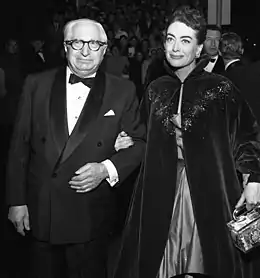
"To me, L.B. Mayer was my father, my father confessor, the best friend I ever had", Crawford was quoted as saying.[84]
After her Academy Award-nominated performance in 1952's Sudden Fear, Crawford continued to work steadily throughout the rest of the decade. After a 10-year absence from MGM, she returned to that studio to star in Torch Song (1953), a musical drama centering on the life of a demanding stage star who falls in love with a blind pianist, played by Michael Wilding. Although the film was highly publicized as Crawford's major comeback, it was a critical and financial failure, known today for its camp appeal. In 1954, she starred in Johnny Guitar, a cult classic directed by Nicholas Ray, co-starring Sterling Hayden and Mercedes McCambridge. She also starred in Female on the Beach (1955) with Jeff Chandler, and in Queen Bee (1955), alongside John Ireland. The following year, she starred opposite a young Cliff Robertson in Autumn Leaves (1956), and filmed a leading role in The Story of Esther Costello (1957), co-starring Rossano Brazzi. Crawford, who had been left near-penniless following Alfred Steele's death,[85] accepted a small role in The Best of Everything (1959). Although she was not the star of the film, she received positive reviews. Crawford later named the role as being one of her personal favorites. By 1961, Joan Crawford was once again her own publicity machine, with a new script, "Whatever Happened to Baby Jane?", sent by Robert Aldrich.[86]
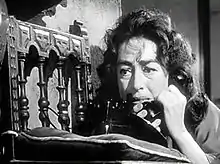
Crawford starred as Blanche Hudson, an elderly, disabled former A-list movie star who lives in fear of her psychotic sister Jane, in the highly successful psychological thriller What Ever Happened to Baby Jane? (1962). Despite the actresses' earlier tensions, Crawford reportedly suggested Bette Davis for the role of Jane. The two stars maintained publicly that there was no feud between them. The director, Robert Aldrich, fueling publicity rumors, explained that Davis and Crawford were each aware of how important the film was to their respective careers, and commented, "It's proper to say that they really detested each other, but they behaved absolutely perfectly."[87]
After filming was completed, their public comments against each other propelled their animosity into a life-long feud. The film was a huge success, recouping its costs within eleven days of its nationwide release reviving Davis and Crawford's careers. Davis was nominated for an Academy Award for her performance as Jane Hudson. Crawford contacted each of the other Oscar nominees in the category (Katharine Hepburn, Lee Remick, Geraldine Page, and Anne Bancroft, all East Coast-based actresses), to let them know that if they could not attend the ceremony, she would be happy to accept the Oscar on their behalf; all agreed. Both Davis and Crawford were backstage - Crawford having presented best director - when the absent Anne Bancroft was announced as the winner and Crawford accepted the award on her behalf. Davis claimed for the rest of her life that Crawford had campaigned against her, a charge Crawford denied.[86]
That same year, Crawford starred as Lucy Harbin in William Castle's horror mystery Strait-Jacket (1964). Robert Aldrich cast Crawford and Davis in Hush...Hush, Sweet Charlotte (1964). After a purported campaign of harassment by Davis on location in Louisiana, Crawford returned to Hollywood entering a hospital. After a prolonged absence, during which Crawford was accused of feigning illness, Aldrich was forced to replace her with Olivia de Havilland. Crawford, who was devastated, said "I heard the news of my replacement over the radio, lying in my hospital bed ... I cried for nine hours."[88] Crawford nursed grudges against Davis and Aldrich for the rest of her life, saying of Aldrich, "He is a man who loves evil, horrendous, vile things", to which Aldrich replied "If the shoe fits, wear it, and I am very fond of Miss Crawford".[89] Despite being replaced, brief footage of Crawford made it into the film when she is seen sitting in a taxi in a wide shot.[90]
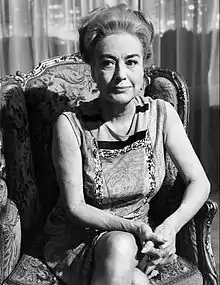
In 1965, she played Amy Nelson in I Saw What You Did, another William Castle vehicle. She starred as Monica Rivers in Herman Cohen's horror thriller film Berserk! (1967). After the film's release, Crawford guest-starred as herself on The Lucy Show. The episode, "Lucy and the Lost Star", first aired on February 26, 1968. Crawford struggled during rehearsals, and drank heavily on-set, leading series star Lucille Ball to suggest replacing her with Gloria Swanson. However, Crawford was letter-perfect the day of the show, which included dancing the Charleston, and received two standing ovations from the studio audience.[91]
In October 1968, Crawford's 29-year-old daughter, Christina (who was then acting in New York on the soap opera The Secret Storm), needed immediate medical attention for a ruptured ovarian tumor. Despite the fact that Christina's character was a 28-year-old, and Crawford was in her sixties, Crawford offered to play her role until Christina was well enough to return, to which producer Gloria Monty readily agreed.[92]
Crawford's appearance in the 1969 television film Night Gallery (which served as pilot to the series that followed) marked one of Steven Spielberg's earliest directing jobs. Crawford made a cameo appearance as herself in the first episode of The Tim Conway Show, which aired on January 30, 1970. She starred on the big screen one final time, playing Dr. Brockton in Herman Cohen's science fiction horror film Trog (1970), rounding out a career spanning 45 years and more than 80 motion pictures. Crawford made three more television appearances, including one as Stephanie White in a 1970 episode ("The Nightmare") of The Virginian and as Joan Fairchild (her final dramatic performance) in a 1972 episode ("Dear Joan: We're Going to Scare You to Death") of The Sixth Sense.[93]
Final years
In 1970, Crawford was presented with the Cecil B. DeMille Award by John Wayne at the Golden Globes, which was telecast from the Coconut Grove at The Ambassador Hotel in Los Angeles. She also spoke at Stephens College, where she had been a student for two months in 1922.[94]
Crawford published her autobiography, A Portrait of Joan, co-written with Jane Kesner Ardmore, in 1962 through Doubleday. Crawford's next book, My Way of Life, was published in 1971 by Simon & Schuster. Those expecting a racy tell-all were disappointed, although Crawford's meticulous ways were revealed in her advice on grooming, wardrobe, exercise, and even food storage. After her death, photographs of John F. Kennedy (for whom she had voted in the 1960 presidential election)[95] were found in her apartment.
In September 1973, Crawford moved from apartment 22-G to a smaller apartment next door, 22-H, at the Imperial House, 150 East 69th Street. Her last public appearance was made on September 23, 1974, at a book party cohosted with her old friend Rosalind Russell at New York's Rainbow Room. Russell was suffering from breast cancer and arthritis at the time. When Crawford saw the unflattering photos that appeared in the papers the next day, she said "If that's how I look, then they won't see me anymore."[96] Crawford cancelled all public appearances, began declining interviews, and left her apartment less and less. Dental problems, including surgery which left her needing round-the-clock nursing care, plagued her from 1972 until mid-1975. While on antibiotics for this problem in October 1974, her drinking caused her to pass out, slip, and strike her face. Whether it was this incident or her return to religion, Christian Science, she quit drinking in 1974.[97]
Death and legacy
On May 6, 1977, Crawford gave away her Shih Tzu, Princess Lotus Blossom, because she was too weak to continue to care for her.[98][99] Crawford died on May 10, 1977, at her apartment in Lenox Hill, New York City, of a myocardial infarction (heart attack).[100] A funeral was held at Campbell Funeral Home, New York, on May 13, 1977. In her will, which was signed on October 28, 1976, Crawford bequeathed to her two youngest children, Cindy and Cathy, $77,500 each from her $2 million estate.
She explicitly disinherited the two eldest, Christina and Christopher: "It is my intention to make no provision herein for my son, Christopher, or my daughter, Christina, for reasons which are well known to them." Both of them challenged the will and received a $55,000 settlement.[101] She also bequeathed nothing to her niece, Joan Lowe (1933–1999; born Joan Crawford LeSueur, the only child of her estranged brother, Hal). Crawford left money to her favorite charities: the USO of New York, the Motion Picture & Television Country House and Hospital, the American Cancer Society, the Muscular Dystrophy Association, the American Heart Association, and the Wiltwyck School for Boys.[102] During World War II, she was a member of American Women's Voluntary Services.[103]
A memorial service was held for Crawford at All Souls' Unitarian Church on Lexington Avenue in New York on May 16, 1977. In attendance were long-time friend Myrna Loy and co-stars Geraldine Brooks and Cliff Robertson, who gave eulogies; Pearl Bailey sang "He'll Understand".[101] Another memorial service, organized by George Cukor, was held on June 24 in the Samuel Goldwyn Theater at the Academy of Motion Picture Arts and Sciences in Beverly Hills, California. Crawford was cremated, and her ashes placed in a crypt with her fourth and final husband, Alfred Steele, in Ferncliff Cemetery, Hartsdale, New York.[104]

Joan Crawford's handprints and footprints are immortalized in the forecourt of Grauman's Chinese Theatre in Hollywood.[105] She has a star on the Hollywood Walk of Fame, at 1752 Vine Street, for her contributions to the motion picture industry.[106] Playboy listed Crawford as #84 of the "100 Sexiest Women of the 20th century".[107] In 1999, Crawford was also voted the tenth greatest female star of the classic American cinema by the American Film Institute.[108]
Crawford has also attracted a following in the gay community. In Joan Crawford: The Essential Biography, the author explains that Crawford appeals to many gay men because they sympathize with her struggle for success in both the entertainment industry and her personal life.[103]
Mommie Dearest
In November 1978, Christina Crawford published Mommie Dearest, which contained allegations that her late adoptive mother was emotionally and physically abusive to Christina and her brother Christopher because she chose fame and her career over parenthood.
Many of Crawford's friends and co-workers, including Van Johnson, Ann Blyth, Myrna Loy, Katharine Hepburn, Cesar Romero, Gary Gray, Douglas Fairbanks Jr. (Crawford's first husband), and Crawford's two other younger daughters, Cathy and Cindy, denounced the book, categorically denying any abuse.[109] Others including Betty Hutton, Helen Hayes,[110] James MacArthur (Hayes' son),[111] June Allyson,[112] and Vincent Sherman[113] stated they had witnessed some form of abusive behavior.
Mommie Dearest became a best-seller, and was made into the 1981 film Mommie Dearest, starring Faye Dunaway as Crawford.[114]
In popular culture
Pictures of Crawford were used in the album artwork of The Rolling Stones album Exile on Main St. (1972).[115]
Four years after her death, Blue Öyster Cult released the song "Joan Crawford" as part of their album Fire of Unknown Origin (1981).
The alleged feud between Crawford and Bette Davis is depicted in the 1989 book Bette and Joan: The Divine Feud. It was fueled by competition over film roles, Academy Awards, and Franchot Tone (Joan Crawford's second husband), who was Davis's co-star in 1935's Dangerous.[116]
The Crawford-Davis rivalry is the subject of the 2017 first season of the television series Feud, inspired by the book and subtitled Bette and Joan. Crawford is played by Jessica Lange, and Davis is played by Susan Sarandon.[117][118] As of 2018, any streaming/airing of this series was stopped by restraint order from lower California courts until Olivia de Havilland could be heard by the United States Supreme Court on whether producers had the right to use her likeness (played by Catherine Zeta-Jones) without permission despite her being a public figure.[119] In January 2019, the Supreme Court refused to hear the case.[120]
Filmography and awards
Autobiographies
- — (1962). A Portrait of Joan: The Autobiography of Joan Crawford. Doubleday. ISBN 978-1-258-17238-1.
- — (1971). My Way of Life. Simon & Schuster. ISBN 978-0-671-78568-0.
Notes
References
- Thomas S. Hischak (2008). The Oxford Companion to the American Musical:Theatre, Film, and Television: Theatre, Film, and Television. Oxford University Press. p. 174. ISBN 978-0-19-533533-0.
Crawford, Joan [born Lucille Fay LeSueur] (1904-1977)
- David Bret (2009). Joan Crawford: Hollywood Martyr. Da Capo Press. p. 8. ISBN 978-0-7867-3236-4.
She was born Lucille Fay LeSueur, most likely on 23 March 1904 (though she always maintained it was 1908, when birth certificates became state mandatory...)
- Mark Knowles (2009). The Wicked Waltz and Other Scandalous Dances: Outrage at Couple Dancing in the 19th and Early 20th Centuries. McFarland. p. 233. ISBN 978-0-7864-3708-5.
Joan Crawford was born Lucille Fay LeSueur in San Antonio, Texas on March 23, 1904. (After she was famous, the date of her birth mysteriously changed to 1906 or 1908)
- Susan Ware (2004). Notable American Women: A Biographical Dictionary Completing the Twentieth Century. Harvard University Press. p. 143. ISBN 978-0-674-01488-6.
offers the birth date of March 23, 1905
- Peter Cowie (2009). Joan Crawford: The Enduring Star. University of Michigan. ISBN 978-0-8478-3066-4.
On March 23, 1908, by her own reckoning (although the real date may have been 1905, or even 1904), Lucille Fay LeSueur was born ...
- Donald Spoto (2010). Possessed: The Life of Joan Crawford. HarperCollins. p. 6. ISBN 978-0-06-202020-8.
- Donna Marie Nowak (2010). Just Joan: A Joan Crawford Appreciation. BearManor Media. pp. 583–. GGKEY:5Y2F5EPURAR.
- Lawrence J. Quirk; William Schoell (2002). Joan Crawford: The Essential Biography. University Press of Kentucky. p. 1. ISBN 978-0-8131-2254-0.
On March 23, 1904, in San Antonio, Texas, Anna Bell Johnson LeSueur gave birth to a little girl, whom she and her husband, Thomas, named Lucille Fay. Lucille was the couple's third child; another daughter, Daisy, had died in infancy, and Lucille's brother, Hal, had been born the previous year. (Many years later, when little Lucille was the famous woman known to the world as Joan Crawford, the year of her birth mysteriously changed to 1906 or 1908.)
- "The Second Rise of Joan Crawford". Life. June 23, 1947. p. 45. ISSN 0024-3019. Retrieved March 23, 2020.
The year of Miss Crawford's birth has been variously identified as 1904, 1906, 1908, and 1909, the last being her own favorite..
- Scott Wilson (2016). Resting Places: The Burial Sites of More Than 14,000 Famous Persons, 3d ed. McFarland. p. 165. ISBN 978-1-4766-2599-7.
Crawford, Joan (Lucille LeSueur, March 23, 1904 – May 10, 1977) San Antonio born film star.... Her ashes were placed in the vault beside the coffin of her husband, with the crypt listing her birth year as 1908.
- Christina Crawford (2017). Mommie Dearest. Open Road Media. ISBN 978-1-5040-4908-5.
My mother was born Lucille LeSueur in San Antonio, Texas, in 1904, although when she came to Hollywood, she lied about her age and changed the year to 1908.:20 Publicly, her birth date was reported as March 23, 1908, but Grandmother told me that she was actually born in 1904.":66
- Miller, Julie. "Fact-Checking Feud: Joan Crawford and Bette Davis's 1963 Oscar Showdown". HWD. Retrieved September 22, 2017.
- Spoto, Donald (February 3, 2011). Possessed: The Life of Joan Crawford. Random House. p. 286. ISBN 978-1-4070-8811-2.
- Day, Elizabeth. "I'll never forgive Mommie: Joan Crawford's daughter gives first interview in 10 years". The Guardian. Retrieved January 29, 2017.
- Bret, David (2009). Joan Crawford: Hollywood Martyr. Da Capo Press. p. 1. ISBN 978-0-7867-3236-4.
- Thomas, Bob (1978). Joan Crawford, a Biography. New York, New York: Simon and Schuster. p. 20. ISBN 978-1-5011-9435-1.
- "THOMAS E. LE SUEUR; Father of Joan Crawford, Film Actress, Dies in Texas (Published 1938)". January 2, 1938 – via NYTimes.com.
- "Joan's father's death notice 2 Jan 1938". January 2, 1938. p. 7 – via newspapers.com.
- Lawrence J. Quirk; William Schoell (2013). Joan Crawford: The Essential Biography. University Press of Kentucky. p. 1. ISBN 978-0-8131-4411-5.
- Considine, p. 4
- Spoto, Donald (2010). Possessed – the Life of Joan Crawford. Harper Collins. pp. 6–14. ISBN 978-0-06-185600-6.
- Newquist, p. 25
- Gallagher, Caitlin. "Joan Crawford's Story About Having Sex With Her Stepfather On 'Feud' Raises Serious Concerns". The Bustle. Retrieved April 21, 2017.
- Quirk, Lawrence J.; Schoell, William (April 6, 2013). Joan Crawford: The Essential Biography. University Press of Kentucky. ISBN 978-0-8131-4411-5.
- Mark Knowles (2009). The Wicked Waltz and Other Scandalous Dances: Outrage at Couple Dancing in the 19th and Early 20th Centuries. McFarland. p. 233. ISBN 978-0-7864-5360-3.
- Lawrence J. Quirk; William Schoell (2013). Joan Crawford: The Essential Biography. University Press of Kentucky. p. 3. ISBN 978-0-8131-4411-5.
- Thomas, pp. 23–24
- Lawrence O. Christensen; William E. Foley; Gary Kremer (1999). Dictionary of Missouri Biography. University of Missouri Press. p. 216. ISBN 978-0-8262-6016-1.
- "The Second Rise of Joan Crawford". Life. June 23, 1947. p. 45. ISSN 0024-3019. Retrieved March 23, 2020.
- Denby, David, "Escape Artist, The Case for Joan Crawford", The New Yorker, January 3, 2011.
- Considine, p. 12
- Granlund, p. 147
- Granlund, p. 135
- Spoto, Donald (February 3, 2011). Possessed: The Life of Joan Crawford. Random House. p. 22. ISBN 978-1-4070-8811-2.
- Crawford, quoted in Newquist, p. 31
- Maas, quoted in LaSalle, p. 123
- Thompson, p. 47
- Paul Donnelley (2003). Fade to Black: A Book of Movie Obituaries. Omnibus. p. 632. ISBN 978-0-7119-9512-3.
- Golden, Eve (2013). John Gilbert: the last of the silent film stars. Lexington, Kentucky: The University Press of Kentucky. ISBN 9780813141640. OCLC 831665560.
- Soares, André (2010). Beyond paradise: the life of Ramon Novarro (Paperback ed.). Jackson: University Press of Mississippi. ISBN 9781604734584. OCLC 758384859.
- Crawford, quoted in LaSalle, p. 120
- Crawford, quoted in Skal, p. 73
- Jennifer M. Bean; Diane Negra (November 21, 2002). A Feminist Reader in Early Cinema. Duke University Press. pp. 235–236. ISBN 0-8223-2999-9.
- Fitzgerald, quoted in Thomas, p. vii
- Basinger, Jeanine, The Star Machine, Knopf Books, 2007, p. 37
- "Joan Crawford Weds in the East". Jefferson City MO Daily Capital News. June 4, 1929.
- "Joan Crawford papers". archives.nypl.org. Retrieved August 12, 2019.
- Thomas, p. 63
- Crawford, quoted in Thomas, p. 65
- Háy, Peter (1991), MGM: When the Lion Roars, Atlanta: Turner Publishing, Inc., p. 72, ISBN 1-878685-04-X
- "SALESGIRLS IN NEW TALKIE.; "Our Blushing Brides" at Capitol Features Joan Crawford". The New York Times. August 2, 1930. ISSN 0362-4331. Retrieved October 31, 2019.
- Leese, p. 18
- "Leading Men of Hollywood: Clark Gable | The Saturday Evening Post". www.saturdayeveningpost.com. Retrieved December 16, 2018.
- Quirk, Lawrence J.; Schoell, William (2013). Joan Crawford, The Essential Biography. University Press of Kentucky. p. 54. ISBN 978-0-8131-4411-5.
- Dickstein, Martin (September 8, 1931). "'This (So Called) Modern Age' at the Capitol, "The Screen"". Brooklyn (New York) Daily Eagle. p. 22, columns 1–2.
- Bret, pp. 63–68
- "The New York Times: Best Pictures". archive.nytimes.com. Retrieved April 21, 2020.
- Sedgwick, John (2000). Popular Filmgoing in 1930s Britain: A Choice of Pleasures. University of Exeter Press. ISBN 978-0-85989-660-3.
- Pawlak, Debra Ann (January 12, 2012). Bringing Up Oscar. Simon & Schuster. ISBN 978-1-60598-216-8.
- Mary Ellen Snodgrass (March 17, 2015). World Clothing and Fashion: An Encyclopedia of History, Culture, and Social Influence. Routledge. pp. 387–388. ISBN 978-1-317-45167-9.
- Marmorstein, Gary (July 16, 2013). A Ship Without A Sail: The Life of Lorenz Hart. New York: Simon & Schuster. p. 218. ISBN 978-1-4165-9426-0.
- "Milestones May 8, 1933". Time. May 8, 1933. Archived from the original on November 22, 2010. Retrieved February 10, 2009.
- "Joan Crawford Film Grosses 1925 – 1970". Box Office Madness. June 29, 2017. Retrieved December 14, 2018.
- Considine, pp. 91–92
- Thomas, p. 94
- Thomas, p. 114
- Considine, pp. 97–98
- Thomas, p. 241
- Thomas, p. 113
- Thomas, p. 115
- T.S. (May 16, 1941). "At the Capitol". The New York Times. ISSN 0362-4331. Retrieved December 14, 2018.
- "Joan Crawford Weds Actor Phillip Terry". Lubbock (TX) Morning Avalanche. UP. July 22, 1942. p. 11.
- Curtiz, quoted in Thomas, p. 146
- Jorgensen, Jay; Scoggins, Donald L. (October 6, 2015). Creating the Illusion: A Fashionable History of Hollywood Costume Designers. Running Press. ISBN 9780762458073.
- Miller, Julie (September 26, 2012). "The Academy Award That Joan Crawford Accepted in Bed Sells; Can You Guess for How Much?". Vanity Fair. Retrieved December 23, 2014.
- Raymond, Barbara Bisantz (April 29, 2009). The Baby Thief: The Untold Story of Georgia Tann, the Baby Seller Who Corrupted Adoption. Hachette Books. ISBN 978-0-7867-3374-3.
- Austin, Linda T. (1990). "Babies for Sale: Tennessee Children's Adoption Scandal". Tennessee Historical Quarterly. 49 (2): 91–102. ISSN 0040-3261. JSTOR 42626860.
- Bret, David (2009). Joan Crawford: Hollywood Martyr. Cambridge, MA: Da Capo Press. ISBN 9780786732364. OCLC 818854961.
- Terrace, Vincent (October 9, 2018). Encyclopedia of Unaired Television Pilots, 1945–2018. Jefferson, NC. ISBN 9781476633497. OCLC 1056952162.
- "Joan Crawford Is Wed in Las Vegas to Businessman". Moberly (MO) Monitor-Index and Democrat. Associated Press. May 10, 1955. p. 8.
- Thomas, p. 190
- "Joan Crawford Dies at Home; Joan Crawford, Screen Star, Dies in Manhattan Home". The New York Times. May 11, 1977. Retrieved August 21, 2007.
- Considine, p. 286
- Hay, p. 22.
- "I'm Broke, Says Joan Crawford". Jefferson City (MO) Post-Tribune. Associated Press. June 1, 1959. p. 1.
- Considine, Shaun (2010). Bette and Joan: the divine feud (Authors Guild backinprint.com ed.). Lincoln, NE: iUniverse.com, Inc. ISBN 978-1450243278. OCLC 650442615.
- Considine, ibid.
- Thomas, p. 225
- Considine, p. 363
- Eu Cinemando (April 23, 2017). "The References: "Feud" Episode 7 + "Hush... Hush... Sweet Charlotte" (Viewers Request)" – via YouTube.
- Thomas, p. 231
- Windeler, Robert (October 23, 1968). "Joan Crawford Takes Daughter's Soap Opera Role". The New York Times. Retrieved January 29, 2017.
- "Joan Crawford on The Sixth Sense". YouTube. Retrieved October 6, 2012.
- Shaun Considine (January 25, 2017). Bette & Joan: The Divine Feud. Graymalkin Media. p. 347. ISBN 978-1-63168-107-3.
- Cowie, Peter. Joan Crawford: The Enduring Star (Rizzoli Universe Promotional Books, March 8, 2011), pp. 204–205
- Considine, p. 396
- Johnnes, Carl. Joan Crawford: The Last Years. Dell Publishing. ISBN 0-440-11536-1.
- Varney, Carleton (1980). There's No Place Like Home: Confessions of an Interior Designer by Carleton Varney (Hardcover ed.). Bobbs-Merrill. ISBN 978-0672518720.
- Thomas, p. 270
- Flint, Peter B. (May 11, 1977). "Joan Crawford Dies at Home". The New York Times. ISSN 0362-4331. Retrieved November 30, 2019.
- Robert., Parish, James (2002). The Hollywood book of death : the bizarre, often sordid, passings of more than 125 American movie and TV idols. Chicago: Contemporary Books. ISBN 0809222272. OCLC 46617003.
- "Daughter Dearest", March 2008, Vanity Fair, p. 2
- Quirk, Lawrence J.; William Schoell (2002). Joan Crawford: The Essential Biography. University Press of Kentucky. p. 235. ISBN 0-8131-2254-6.
- Wilson, Scott. Resting Places: The Burial Sites of More Than 14,000 Famous Persons, 3d ed.: 2 (Kindle Locations 10300-10301). McFarland & Company, Inc., Publishers. Kindle Edition.
- "LIFE". Life. March 1, 1937. p. 49. ISSN 0024-3019. Retrieved March 23, 2020.
- "Hollywood Walk of Fame – Joan Crawford". walkoffame.com. Hollywood Chamber of Commerce. Retrieved April 17, 2017.
- "Playboy Ranks 100 Sexiest Stars of the Century in January Issue" (Press release). Playboy Enterprises. Archived from the original on January 13, 2012. Retrieved March 11, 2012.
- Susan Ware (2004). Notable American Women: A Biographical Dictionary Completing the Twentieth Century. Harvard University Press. p. 142. ISBN 978-0-674-01488-6.
- Considine, p. 412
- Hayes, Helen; Hatch, Katherine (1990). My Life in Three Acts. Harcourt, Brace Jovanovich. ISBN 0-15-163695-8.
- Strouse, Jean (1978). "Mommie Monster" Newsweek: Volume 92, Issues 10–18, p. 134.
- Allyson, June; Leighton, Frances Spatz (1983). June Allyson. New York: Berkley. pp. 77–84. ISBN 0-425-06251-1.
- Sherman, Vincent (1996). Studio Affairs: My Life As a Film Director. University Press of Kentucky. pp. 209–213. ISBN 0813119758.
- Roger Ebert (January 1, 1981). "Mommie Dearest", Chicago Sun-Times; accessed March 12, 2017.
- "popsike.com - ROLLING STONES EXILE ON MAIN STREET 1972 COC UK 1st Press 2LP Excellent - auction details". www.popsike.com.
- Rorke, Robert (February 26, 2017). "Why Bette Davis and Joan Crawford's Feud Lasted a Lifetime". The New York Post. Retrieved February 26, 2017.
- Wagmeister, Elizabeth (May 5, 2016). "Feud: Ryan Murphy Lands Third FX Anthology With Susan Sarandon, Jessica Lange". Variety. Retrieved May 5, 2016.
- Birnbaum, Debra (January 12, 2017). "FX Sets Premiere Dates for Feud, The Americans, Archer". Variety. Retrieved January 12, 2017.
- "Olivia de Havilland, Now 102, Will Take 'Feud' to Supreme Court". The Hollywood Reporter. Retrieved November 12, 2018.
- "Supreme Court won't hear Olivia de Havilland case that 'Feud' depicted her as gossipmonger". USA Today. Retrieved February 19, 2019.
Bibliography
Sources
- Considine, Shaun (1989). Bette and Joan: The Divine Feud. New York, E. P. Dutton, a division of Penguin Books. ISBN 0-525-24770-X.
- Bret, David (2006). Joan Crawford: Hollywood Martyr. Robson. ISBN 1-86105-931-0.
- Granlund, Nils T. (1957). Blondes, Brunettes, and Bullets. New York, David McKay Company.
- Hoefling, Larry J. (2008). Nils Thor Granlund: The Swedish Showman Who Invented American Entertainment. Inlandia Press. ISBN 0-9822313-0-X.
- LaSalle, Mick (2000). Complicated Women: Sex and Power in Pre-Code Hollywood. New York, Thomas Dunne Books, an imprint of St. Martin's Press. ISBN 0-312-25207-2.
- Dunaway, Faye (1998). Looking For Gatsby. Pocket. ISBN 0-671-67526-5.
- Leese, Elizabeth (1991). Costume Design in the Movies. Dover Books. ISBN 0-486-26548-X.
- Newquist, Roy, with introduction by John Springer (1980). Conversations with Joan Crawford. New Jersey, Citadel Press, a division of Lyle Stuart, Inc. ISBN 0-8065-0720-9.
- Quirk, Lawrence J. and William Schoell. (2002). Joan Crawford: the essential biography. University Press of Kentucky. ISBN 0813122546.
- Skal, David J. (1993). The Monster Show: A Cultural History of Horror. Penguin Books. ISBN 0-14-024002-0.
- Thomas, Bob (1978). Joan Crawford: A Biography. New York, Bantam Books. ISBN 0-553-12942-2.
External links
- Joan Crawford at the Internet Broadway Database

- Joan Crawford at IMDb
- Joan Crawford at the TCM Movie Database

- Joan Crawford at AllMovie
- Excerpt of March 2008 biography, VanityFair.com
- Joan Crawford at Curlie
- Joan Crawford profile, Virtual-History.com
- Joan Crawford awards at Brandeis University